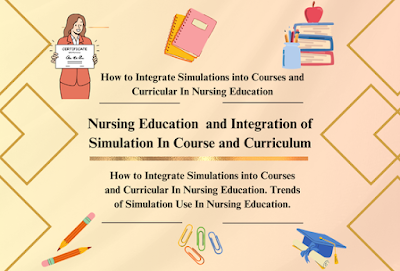The Integration of Simulation In Course and Curriculum In Nursing Education. Through simulation, nursing students can practice their clinical skills and abilities, make errors that are not life-threatening to patients, and repeat the process (multiple times) to master the skills.
The Integration of Simulation In Course and Curriculum In Nursing Education
Integrating simulation into nursing education involves the use of simulated scenarios to replicate real-life clinical situations and provide students with a safe, controlled environment in which to practice their skills and learn from mistakes. This approach promotes learning, builds confidence, and prepares students for clinical practice.
1. Integrating Simulations into Courses and Curricula
Simulations are becoming an essential component in nursing education, providing a dynamic approach to active and experiential learning. These simulations can be seamlessly integrated into various aspects of nursing education, including:
- Courses: Simulations can be incorporated into theoretical courses to enhance understanding and application of concepts.
- Laboratory Experiences: Simulated labs offer hands-on practice in a controlled environment, allowing students to develop practical skills.
- Clinical Courses: Simulations in clinical courses prepare students for real-world scenarios and enhance their clinical decision-making abilities.
As clinical placements become increasingly challenging to secure, many nursing programs and state boards of nursing are turning to simulations as a substitute or supplement for traditional clinical experiences (Katz et al., 2010). This approach helps ensure that students receive the necessary training to excel in their future roles.
2. Trends in Simulation Use in Nursing Education
Recent advancements in electronic communications and the growing acceptance of online learning have led to the evolution of simulation technologies. Key trends include:
- Virtual Simulations: Virtual platforms now combine face-to-face simulation pedagogy with electronic multimedia, creating interactive and learner-mediated activities. Virtual simulations can range from technical skills training to complex case-based scenarios requiring critical thinking and clinical decision-making (Cant & Cooper, 2014). Popular software products for virtual simulations include ArchieMD, CliniSpace, Second Life, TINA, Virtual Heroes, and Sim.
- Enhanced Course Integration: Educators are increasingly integrating simulations into diverse courses. For example:
- Senior Leadership Courses: Thomas, Hodson Carlton, and Ryan (2010) used simulations to prepare new graduates for clinical practice, addressing issues like staffing problems, physician interactions, and crisis interventions.
- End-of-Life Care: Hamilton (2010) employed simulations to help students cope with end-of-life stressors, using materials from the End-of-Life Nursing Education Consortium.
- Maternal and Child Health: Bantz et al. (2007) implemented a comprehensive laboratory and virtual clinical experience to enhance students’ preparedness for maternal-newborn care.
- Patient Safety: DeBourgh and Prion (2010) utilized simulations to teach fall prevention and patient safety, showing significant knowledge and skill improvements.
- Pharmacology and Communication: Thompson and Bonnel (2008) integrated high-fidelity simulations into pharmacology courses, while Rosenzweig, Hravnak, and Magdic (2008) developed simulations to assess communication skills in acute care settings.
3. Online Role-Play and Unfolding Case Studies
- Online Role-Play Simulations: Nelson and Blenkin (2007) used online role-play simulations to teach professional and personal relationship management, including handling difficult behavior and patient interactions. These simulations provided realistic scenarios and resources for student learning.
- Unfolding Case Studies: Unfolding cases are gaining popularity for their ability to engage students in interactive, problem-solving scenarios. These cases can:
- Teach Quality and Safety: Durham and Sherwood (2008) used unfolding cases to integrate quality and safety concepts into nursing practice.
- Enhance Critical Thinking: Batscha and Moloney (2005) used online unfolding cases to develop students’ analytical and organizational skills.
- Reveal Problem-Solving Flaws: Azzarello and Wood (2006) highlighted the use of unfolding cases to uncover and address gaps in students’ problem-solving abilities.
Unfolding cases are adaptable to various educational settings, including traditional and flipped classrooms, offering a flexible approach to interactive learning (Educause Learning Initiative, 2012).
Conclusion
The integration of simulations into nursing education offers a robust approach to bridging theoretical knowledge with practical application. As simulation technologies continue to evolve, they provide valuable opportunities for students to engage in meaningful, interactive learning experiences that enhance their readiness for clinical practice. Educators must stay informed about these advancements and continually adapt their teaching strategies to maximize the benefits of simulations in nursing education.
Read More:
https://nurseseducator.com/didactic-and-dialectic-teaching-rationale-for-team-based-learning/
https://nurseseducator.com/high-fidelity-simulation-use-in-nursing-education/
First NCLEX Exam Center In Pakistan From Lahore (Mall of Lahore) to the Global Nursing
Categories of Journals: W, X, Y and Z Category Journal In Nursing Education
AI in Healthcare Content Creation: A Double-Edged Sword and Scary
Social Links:
https://www.facebook.com/nurseseducator/
https://www.instagram.com/nurseseducator/
https://www.pinterest.com/NursesEducator/
https://www.linkedin.com/in/nurseseducator/
https://www.researchgate.net/profile/Afza-Lal-Din
https://scholar.google.com/citations?hl=en&user=F0XY9vQAAAAJ
